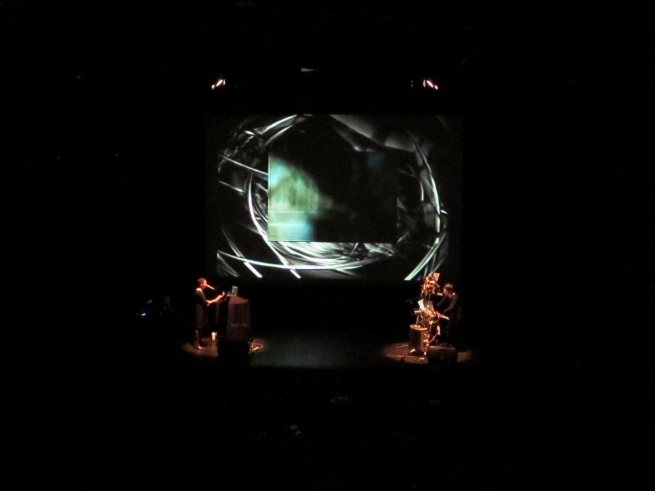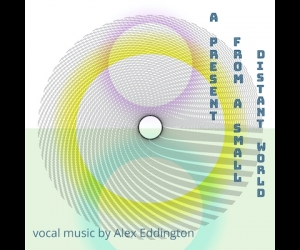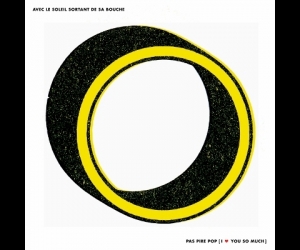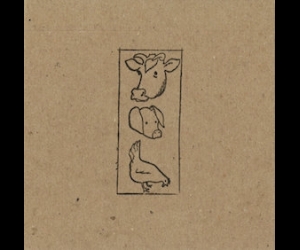
The Vancouver New Music Festival, under the artistic direction of Giorgio Magnanensi, is known for inviting performers from the breadth of the contemporary art world, featuring emerging artists alongside international celebrities, the whole lot unapologetically challenging the audience with demanding performances. In presenting such a wide range of artists, the festival often evokes controversy. “I like to present for all perspectives,” states Magnanensi. “I suspend my personal tastes and I look to see what is being presented out there, and I bring that.”
Context seemed to be the underlying theme of this year’s festival, advertised as “A festival of visual music, abstract cinema, experimental animation, lumia, cymatics, and interactive live audiovisual performance.” The venue, arranged like a cabaret, with tables, chairs, and a slightly raised stage with a large screen behind, created a performance expectation that was at times restrictive for works that may have been more effective in dance clubs or as installations. As one audience member stated, “ The lines between installation and performance are blurring, and things that work best as installations are being placed as performances. The lines could be more distinctly drawn, as there are different sets of expectations that lead to negative reactions of a performance that would have been overwhelmingly positive if it were an installation.”
The festival started with the cymatic work of Vancouver artists Kristin Roos and Josh Nite, which involved directing loud, low sonic rumbles at pools of water, and projecting the images of the water’s vibrations on screen. Although the projected visuals were intriguing, during the performance the artist ambled about onstage, hands in pockets and looking lost, distracting the audience’s attention. Yet the relationship of sound to image was fascinating, and as an installation it would have been extremely successful.
There were a number of performances with intriguingly artful visuals accompanied by markedly loud sound that would have been better suited to a club or rave setting. Of these, Saskatoon’s Carrie Gates’ and Jon Vaughn’s intriguing low-tech, audio-and-video-feedback piece produced complex, well-integrated imagery with organic hisses, pops, and buzzes, at impressive volumes. Magnanensi observed that there was “an innocence that is part of the aesthetic, a planned naïveté. This kind of music is a behaviour, an anarchist approach to rewiring. This is more of an activity than a performance.”
Australian artist Robin Fox’s dancing laser, combined with bleeding-ear audio, felt awkward and hampered in the small theatre. The link between music and laser in Fox’s work was evident, as each tone affected the ever-changing beam that, fractured into thousands of smaller beams, swathed the audience. There was a magnificence in this barrage on the senses, but it desperately needed a large expanse for the sound and laser to have full effect. In the proper environment, this performance would have reached its full magnitude and created a sense of awe.
Three shows during the festival lent themselves to repeated viewing in an art gallery setting. Vancouver’s Victor Ballasteros, Ross Birdwise, and Soressa Garder created an intriguing video using sound and visual loops, slow motion, and repetition. At times minimalistic, this was quite captivating. Dutch lumia artist Joost Rekveld presented live visual renderings of growth processes: images of constantly evolving organic structures. The slowly shifting images could have been frozen at any point to provide stunning individual works that, had they been on canvas, could have been proudly displayed in any gallery. The addition of a shifting four-channel sound, produced by Magnanensi, made this an aesthetic feast. Again, however, the theatre was too small, and this work felt cramped and stifled.
Montreal’s Herman Kolgen’s stunning and disturbing video-performance work Inject felt similarly out of place. This was like watching a movie of a disturbed world, familiar but not within the rules of our reality, and containing elements reminiscent of Asian horror films—extremely beautiful, while intensely disturbing. The soundtrack used many noise elements musically to create a disjointed narrative.
Ideally suited to the performance space were two shows that did not try to surround, immerse, or overwhelm the audience, but instead invited it into the shows’ worlds. The first was the pairing of Vancouver’s Stefan Smulovitz on computer and viola, with Quebec native Pierre Hébert’s live improvised animation. This was a powerful and disturbing piece, built upon the audio recordings of flies caught between two windows. Dots on the screen grew to take on life as animated flies, while the images became complex, colourful, perpetually moving abstractions, all with an artistic elegance. The sound of the viola was transformed through granular synthesis and numerous other audio techniques to become an orchestra of flies filling the room, slowly morphing into percussion, and then back into flies. Everything moved together in a chaotic symphony of sound, colour, and light, and the effect was totally engaging. The complexity voiced in a single note of the viola was so much more powerful than any of the electronically produced sounds in the festival.
Vancouver’s Jamie Griffiths’ and Viviane Houle’s artfully understated performance was the most exciting show of the festival, as well as the quietest. Griffiths’ constantly changing cat’s cradle of string creatures mutated with every gesture into amorphous, amphibious shapes, and interacted directly with Houle’s multi-charactered vocal expressions. Houle moved through a surprising number of beautifully expressive voices, accompanied by her subtly poetic use of loops. Both performers displayed a high level of craft, yet there was vulnerability in the work that let you enter, providing an inner world to explore, and a depth to ponder. As one audience member put it, “Now that’s real art.”
I left this festival amazed at how much I was educated, the level of unique creative works I experienced, the number of discussions on the presentations into which I had entered, and how stimulated my eyes, ears, and soul were. I have seldom attended a festival anywhere where I had so many reactions and interactions. I am glad I have a year to digest this before next year’s festival.
Image: Vivian Houle and Jamie Griffiths. Image by: Heather McDermid.


